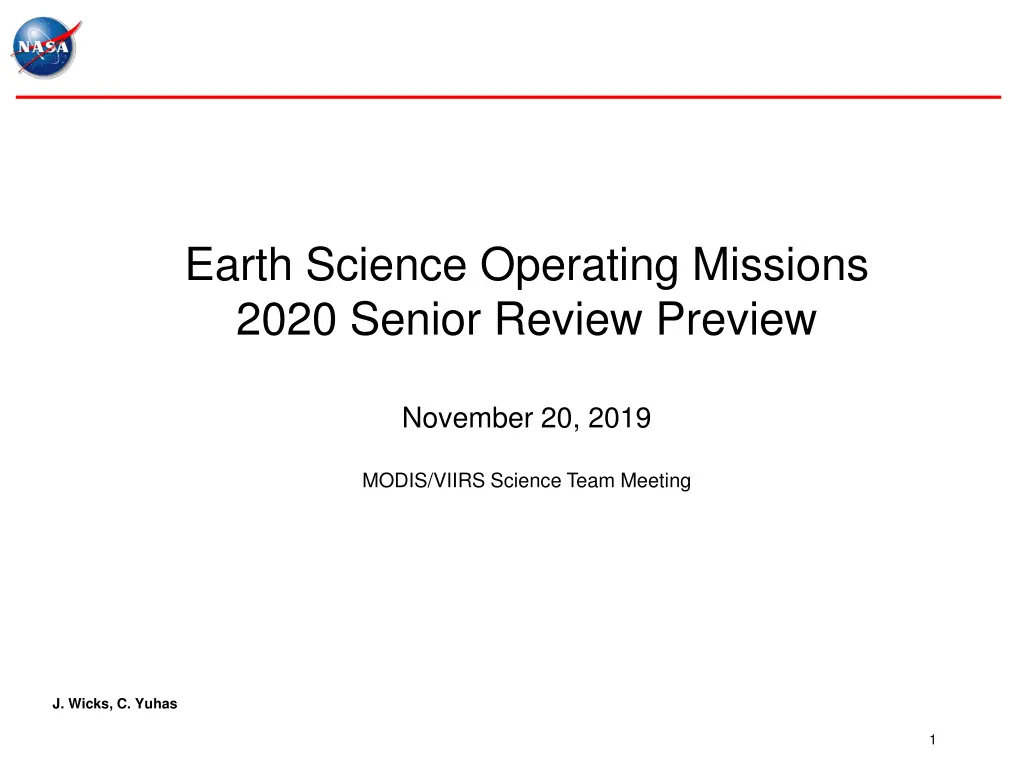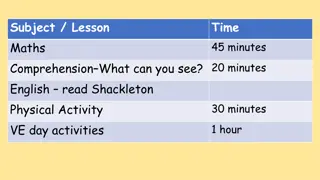
Maximizing Scientific Value of Earth Science Missions 2020 Senior Review
Explore the objectives, schedule, and evaluation criteria of the Earth Science Operating Missions 2020 Senior Review, emphasizing the importance of maximizing the scientific value of on-orbit observing assets within available resources while prioritizing long-term data continuity and national objectives.
Download Presentation

Please find below an Image/Link to download the presentation.
The content on the website is provided AS IS for your information and personal use only. It may not be sold, licensed, or shared on other websites without obtaining consent from the author. If you encounter any issues during the download, it is possible that the publisher has removed the file from their server.
You are allowed to download the files provided on this website for personal or commercial use, subject to the condition that they are used lawfully. All files are the property of their respective owners.
The content on the website is provided AS IS for your information and personal use only. It may not be sold, licensed, or shared on other websites without obtaining consent from the author.
E N D
Presentation Transcript
Earth Science Operating Missions 2020 Senior Review Preview November 20, 2019 MODIS/VIIRS Science Team Meeting J. Wicks, C. Yuhas 1
Senior Review Objective Within available resources, maximize science value of the ESD on-orbit observing assets, within the constraints of the overall Program of Record and ESD s commitment to the Decadal Survey. This is a comparative review in which the primary evaluation factor is the scientific value of the dataset, with attention to the value of science that will be enabled by the extension of the dataset. The ESD Senior Review explicitly acknowledges the importance of long term data sets and overall data continuity for Earth science research; the direct contributions of mission data to national objectives, such as the routine use of near-real-time products from NASA research missions for applied and operational purposes by U.S. public organizations. 2
Senior Review Schedule Schedule ESD Steering Committee Kickoff Notification to ESAC Draft Call Letter to Missions Notification to excluded missions Mission Scientists Pre-Proposal Briefing @ AGU Request for Inclusion due from excluded missions Final Call Letter Proposals Due National Interests Panel and Technical Review Science Panel (Telecon) Questions to the Mission Teams Science Panel (Mission Presentations) Science Panel Report to ESAC PPBE2022/Senior Review Budget Decisions Results to ESD Steering Committee Guidance Letters to Missions Mission Response Nov 13 TBD Dec 2 Dec 2 Dec 8 Dec 19 Dec 20 Mar 6 Apr 14-16 Apr 21 Apr 24 May 12-14 June May Aug Aug Aug Sep 30 3
Evaluation Criteria ESD s priority for the Mission Teams for the 2020 Review: Relevance of the Extended Mission to the 2017 Decadal Survey Science: Scientific merit of the mission datasets with the proposed years of additional data collection, with special attention to the science that will be enabled by extension. Merit is based on their intrinsic value in research investigations by the community, relevance to Decadal Survey, and uniqueness of the data among the global observing resources; Quality trends of the standard data products, with a focus on the projected quality for the years of the requested extension, including any change induced by sensor, platform or orbit changes, and the effect of such changes on the overall consistency of the dataset, recognizing the value of long- term data records; Operational and non-research uses: Utility of the products for applied and operational uses that serve national interests, including operational uses, public services, business and economic uses, military operations, government management, policy making, etc. Evaluation factors: intrinsic value, frequency of use, latency. Technical & Cost: Hardware status and performance, life expectancy. Mission operations plans for health, safety and data collection. Cost realism, and share of the overall budget projected for the Program of Record as specified in the Decadal Survey 4
Terra & Aqua Senior Review Proposals The Terra and Aqua Senior Review Proposals should include any orbit changes predicted during the review period and how those changes will impact the consistency of the dataset and the long-term record. Missions update End of Mission Plans within 60 days of submitting Senior Review extension proposal and 30 days before the ESD decision (per requirement 3.3.1(f) of 8715.6B) 5
Terra & Aqua Existing Algorithm Maintenance The Terra and Aqua Project Scientists now manage the existing algorithm grants, formerly managed under ROSES, within the Flight Project. To facilitate the Project Scientists renewal of the non-NASA PI grants, mini-proposals will be requested and appended to the Terra and Aqua proposals and the ESD decision letter at the end of the Senior Review will list each of the PI/products to be continued. The format and requirements for the mini-proposals will be set by the Terra and Aqua Project Scientists, with the concurrence of ESD Operating Missions Program Executive. The Terra and Aqua proposals will summarize the mini-proposals in the body of the missions main proposals and report progress since last SR. Individual assessments by the panel of each algorithm mini-proposal will not be required, but reviewers may comment on an individual product/algorithm (as for any other mission and its products). The inclusion in the Senior Review process of the EOS Data Continuity Products using the S-NPP and JPSS mission data is being considered. S-NPP instrument teams will need to provide an overall status of the quality of the data products and readiness for transition. If S-NPP is ready to be included in the Senior Review process we will most likely follow a process similar to MODIS, but that is TBD and will be included in the guidance letter. JPSS is under discussion. 6
Questions? jamie.wilson.wicks@nasa.gov Cheryl.Yuhas@nasa.gov 7





